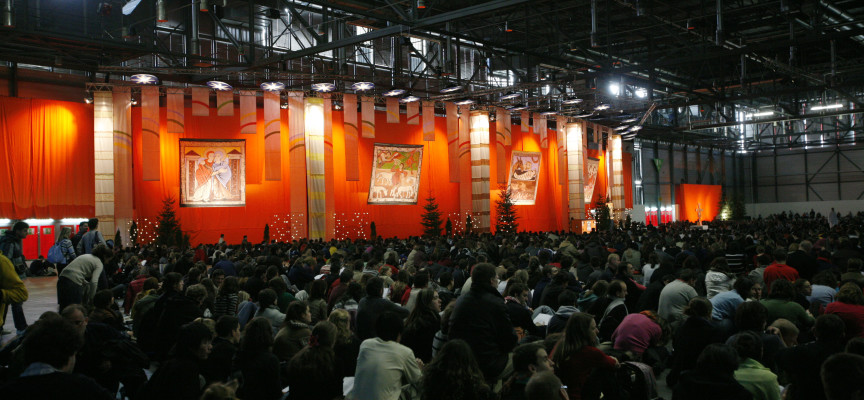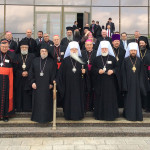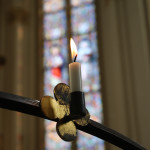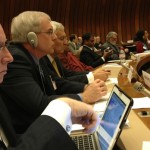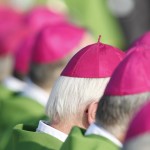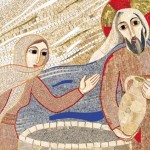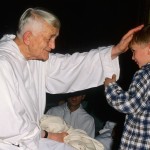From 29th December to 2nd January, 2015, the Taizé community will host in the Czech capital the 37th European youth meetings it organizes at the end of each year. Here are some echoes of the preparation.
In a few weeks in Prague will stream thousands of young people who are preparing now, from one end to the other of the continent, to live this Czech stage of the “pilgrimage of trust” led by Taizé since the late 70s. Among these young people, the presence of many participants from Poland, Ukraine and Belarus will mark the gathering, but the French, Germans and Italians will also be very numerous.
In Prague, the international and ecumenical team preparing the event has taken up residence, since September, in the heart of the historic centre of the city, in the “Kafka house” named after its most famous occupant. On three floors, a hive burst with activities. For the first time, the year-end meeting preparation centre houses an exhibition presenting Taizé, the youth meetings, the artistry and craftsmanship of the brothers.
A room at the end of this journey has been dedicated to the memories of the last Taizé meeting in Prague in 1990. In many local Christian communities, the meeting, which was held a year after the fall of the Berlin Wall, after a historic year in many ways, is well present in memory. Tens of thousands of young people had then met, form Eastern and Western Europe, often taken in by families.
This experience of hospitality is one of the highlights for the young people who participate in Taizé meetings. It is now also one of the biggest challenges because several thousand seats to accommodate the young pilgrims in Prague and the surrounding towns and villages are still lacking. In a region of Europe among the most secularized Christians yet dare reach out to others, offering to all, believers or not, to host them and the young.
During the weekend “open house” held in the centre of preparation, mid-November, we were surprised to see how many young people were present, sent by their priest or pastor to represent their parish. The local group preparing the home in a neighborhood or village often consists of several young, some still teenagers: it is certainly a great sign of hope for the Church’s vitality in the future.
Another challenge of the moment is to finalize the logistical and practical details. As enrollment exceeded expectations, a marquee is being leased to add a great place of prayer to the four already provided for in the exhibition park Letňany, which will host the evening prayers. At noon, the youth will go pray with brothers simultaneously in 16 churches in the city center.
The program is being finalized, such as the list of thirty workshops allowing those who wish to deepen in the afternoon questions grouped around four main themes: faith, the Church, solidarity and art. Many speakers are involved, and also important places of the city such as the St. Vitus Cathedral, the Museum of Contemporary Art or the Monastery of Bila Hora, which is symbol of the dramas lived in the seventeenth century between Catholics and Hussites.
In a difficult historical context, we hope that this experience of house welcoming and brotherhood will mark the people who open their doors, like the young of so many different backgrounds. In this regard, a recent speech by Pope Francis is particularly appropriate. November 30th, while attending the Divine Liturgy celebrated by Ecumenical Patriarch Bartholomew at the Phanar in Istanbul, he referred to the search for full communion between the Churches and cited three “voices” calling especially for this unit: the poor, victims of conflict and the young. Speaking of the latter, he added: “It is precisely young people – I think for example of the multitudes of young Orthodox, Catholics and Protestants who meet in international gatherings organized by the Taizé community – who now ask us to make steps towards full communion . And this not because they ignore the significance of the differences that still separate us, but because they know how to see beyond, they are able to gather the essential that already unites us”.
Du 29 décembre au 2 janvier 2015, la communauté de Taizé animera dans la capitale tchèque la 37e des rencontres européennes de jeunes qu’elle organise à la fin de chaque année. Voici quelques échos de la préparation.
Dans quelques semaines, afflueront à Prague des milliers de jeunes qui se préparent en ce moment, d’un bout à l’autre du continent, à vivre cette étape tchèque du “pèlerinage de confiance” animé par Taizé depuis la fin des années 70. Parmi ces jeunes, la présence de nombreux participants de la Pologne, de l’Ukraine et de la Biélorussie marquera le rassemblement, mais les Français, les Allemands et les Italiens seront aussi très nombreux.
À Prague, l’équipe internationale et œcuménique qui prépare l’événement a élu domicile, depuis septembre, au cœur du centre historique de la ville, dans la “maison Kafka” du nom de son plus illustre occupant. Sur trois étages vit une véritable ruche, foisonnant d’activités. Pour la première fois, le centre de préparation de la rencontre de fin d’année abrite une exposition présentant Taizé, les rencontres de jeunes, le travail artistique et artisanal des frères.
Une pièce au bout de ce parcours a été dédiée aux souvenirs de la dernière rencontre de Taizé à Prague, en 1990. Dans beaucoup de communautés chrétiennes locales, on se souvient en effet de ce rassemblement qui se tint un an après la chute du mur de Berlin, au terme d’une année historique à bien des égards. Des dizaines de milliers de jeunes s’étaient alors retrouvés, de l’Est et de l’Ouest de l’Europe, souvent accueillis dans des familles.
Cette expérience de l’hospitalité est une des plus marquantes pour les jeunes qui participent aux rencontres de Taizé. C’est actuellement aussi l’un des plus grands défis, car il manque encore plusieurs milliers de places pour loger les jeunes pèlerins à Prague et dans les villes et villages alentour. Dans une région d’Europe parmi les plus sécularisées, des chrétiens osent pourtant aller vers les autres, proposant à tous, croyants ou non, d’héberger eux aussi des jeunes.
Lors du week-end “portes ouvertes” qui s’est tenu au centre de préparation, à la mi-novembre, nous étions étonnés de constater combien de jeunes étaient présents, envoyés par leur prêtre ou leur pasteur pour représenter leur paroisse. Le groupe local qui prépare l’accueil dans un quartier ou un village est souvent constitué de plusieurs jeunes, parfois encore adolescents : c’est sans nul doute un grand signe d’espérance pour la vitalité ecclésiale à l’avenir.
Un autre défi du moment est de mettre la dernière main aux détails logistiques et pratiques. Comme les inscriptions ont dépassé les prévisions, un chapiteau est en train d’être loué pour ajouter un grand lieu de prière aux quatre déjà prévus au parc des expositions de Letnaňy, où auront lieu les prières du soir. À midi, les jeunes iront prier avec des frères simultanément dans 16 églises du centre-ville.
Le programme est en cours de finalisation, par exemple la liste des trente ateliers permettant à ceux qui le souhaitent d’approfondir l’après-midi des questions regroupées autour de quatre grands thèmes : la foi, l’Église, la solidarité et l’art. De nombreux intervenants sont mis à contribution, et aussi des lieux importants de la ville, comme la cathédrale Saint-Guy, le musée d’art contemporain ou le monastère de Bila Hora, lieu symbole des drames vécus au XVIIe siècle entre catholiques et hussites.
Dans un contexte historique difficile, nous espérons que cette expérience d’accueil et de fraternité va marquer les habitants qui ouvriront leur porte, tout comme les jeunes de tant d’horizons différents. À cet égard, une parole récente du Pape François est particulièrement à propos. Le 30 novembre, alors qu’il assistait à la divine liturgie célébrée par le patriarche œcuménique Bartholomée au Phanar d’Istanbul, il a évoqué la recherche de la pleine communion entre les Églises et il a cité trois “voix” appelant plus spécialement à cette unité : les pauvres, les victimes de conflits et les jeunes. Parlant de ces derniers, il a ajouté: “Ce sont justement les jeunes – je pense par exemple aux multitudes de jeunes orthodoxes, catholiques et protestants qui se rencontrent dans les rassemblements internationaux organisés par la communauté de Taizé – qui aujourd’hui nous demandent de faire des pas en avant vers la pleine communion. Et cela non parce qu’ils ignorent la signification des différences qui nous séparent encore, mais parce qu’ils savent voir au-delà, ils sont capables de recueillir l’essentiel qui déjà nous unit”.
Taizé torna a Praga
Dal 29 dicembre al 2 gennaio 2015, la comunità di Taizé animerà nella capitale ceca il 37° incontro europeo dei giovani, organizzato alla fine di ogni anno. Ecco alcuni echi dalla preparazione.
Tra un paio di settimane a Praga arriveranno migliaia di giovani che si stanno preparando, da un capo all’altro del continente a vivere questa tappa ceca del “pellegrinaggio di fiducia” guidato da Taizé dalla fine degli anni ’70. Tra questi giovani, la presenza di numerosi partecipanti provenienti da Polonia, Ucraina e Bielorussia segnerà l’incontro, ma francesi, tedeschi e italiani saranno altrettanto numerosi.
A Praga, un team internazionale ed ecumenico che prepara l’evento si è insediato da settembre nel cuore del centro storico della città, nella “casa Kafka” dal nome del suo più celebre occupante. Su tre piani vive un vero alveare, pieno di attività. Per la prima volta, il centro di preparazione dell’incontro di fine anno ospita una mostra che presenta Taizé, gli incontri giovanili, il lavoro artistico e artigianale dei fratelli.
Una stanza alla fine di questo percorso è dedicata ai ricordi dell’ultimo incontro di Taizé a Praga nel 1990. In molte comunità cristiane locali, si ricorda infatti questo incontro che si è svolto un anno dopo la caduta del muro di Berlino, alla fine di un anno storico da molti punti di vista. Decine di migliaia di giovani si erano ritrovati, dall’Europa orientale e occidentale, in molti accolti da famiglie.
Questa esperienza dell’ospitalità è uno dei tratti che segna di più i giovani che partecipano agli incontri di Taizé. Ora è anche una delle più grandi sfide, perché mancano ancora diverse migliaia di posti per accogliere i giovani pellegrini a Praga, nelle città e villaggi circostanti. In una regione d’Europa tra le più secolarizzate, i cristiano osano ancora andare verso gli altri, proponendo a tutti, credenti o meno, di ospitare anche loro dei giovani.
Durante il fine settimana “porte aperte” che si è tenuto al centro della preparazione, a metà novembre, siamo rimasti sorpresi nel vedere come molti giovani erano presenti, mandati dai loro sacerdoti o pastori per rappresentare la loro parrocchia. I gruppi locali che preparano l’accoglienza in un quartiere o un villaggio sono spesso costituiti da giovani, talvolta ancora adolescenti: è senza alcun dubbio un grande segno di speranza per la vitalità della Chiesa in futuro.
Un’altra sfida del momento è mettere a punto i dettagli logistici e pratici. Siccome le iscrizioni hanno superato le previsioni, si sta affittando un tendone per aggiungere un grande luogo di preghiera oltre i quattro già previsti al parco delle esposizioni Letňany, dove si svolgeranno le preghiere della sera. A mezzogiorno, i giovani andranno a pregare con i fratelli contemporaneamente in 16 chiese nel centro della città.
Il programma è in fase di definizione, come ad esempio l’elenco dei trenta workshop che permetteranno a coloro che lo desiderano, di approfondire nel pomeriggio domande attorno a quattro temi principali: la fede, la Chiesa, la solidarietà e l’arte. Contribuiranno molte persone con i loro interventi e sono coinvolti anche luoghi importanti della città quali la Cattedrale di San Vito, il Museo di Arte Contemporanea e il Monastero di Bila Hora, luogo simbolico dei drammi vissuti nel XVII secolo tra cattolici e hussiti.
In un contesto storico difficile, la nostra speranza è che questa esperienza di accoglienza e di fraternità segni le persone che apriranno le loro porte, così come ai giovani di tanti contesti diversi. A questo proposito, un recente discorso di Papa Francesco è particolarmente significativo. Il 30 novembre, quando ha partecipato alla Divina Liturgia celebrata dal Patriarca Ecumenico Bartolomeo al Fanar di Istanbul, ha fatto riferimento alla ricerca della piena comunione tra le Chiese e ha citato tre “voci”, che invitano in modo particolare a questa unità: i poveri, le vittime dei conflitti e i giovani. Parlando di questi ultimi, ha aggiunto: “Sono proprio i giovani – penso ad esempio alle moltitudini di giovani ortodossi, cattolici e protestanti che si incontrano nei raduni internazionali organizzati dalla comunità di Taizé – sono loro che oggi ci sollecitano a fare passi in avanti verso la piena comunione. E ciò non perché essi ignorino il significato delle differenze che ancora ci separano, ma poiché sanno vedere oltre, sono capaci di cogliere l’essenziale che già ci unisce”.
Latest posts by Frere Benoît (see all)
- Taizé back to Prague - 9 dicembre 2014
- A Europe of fraternity - 27 ottobre 2014

